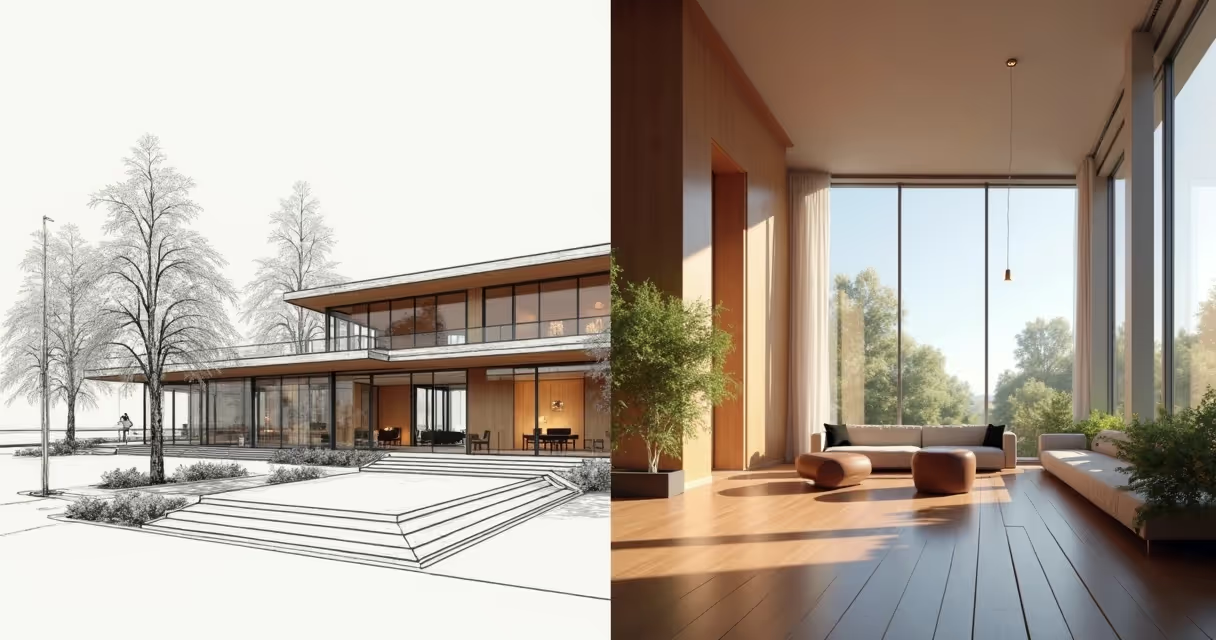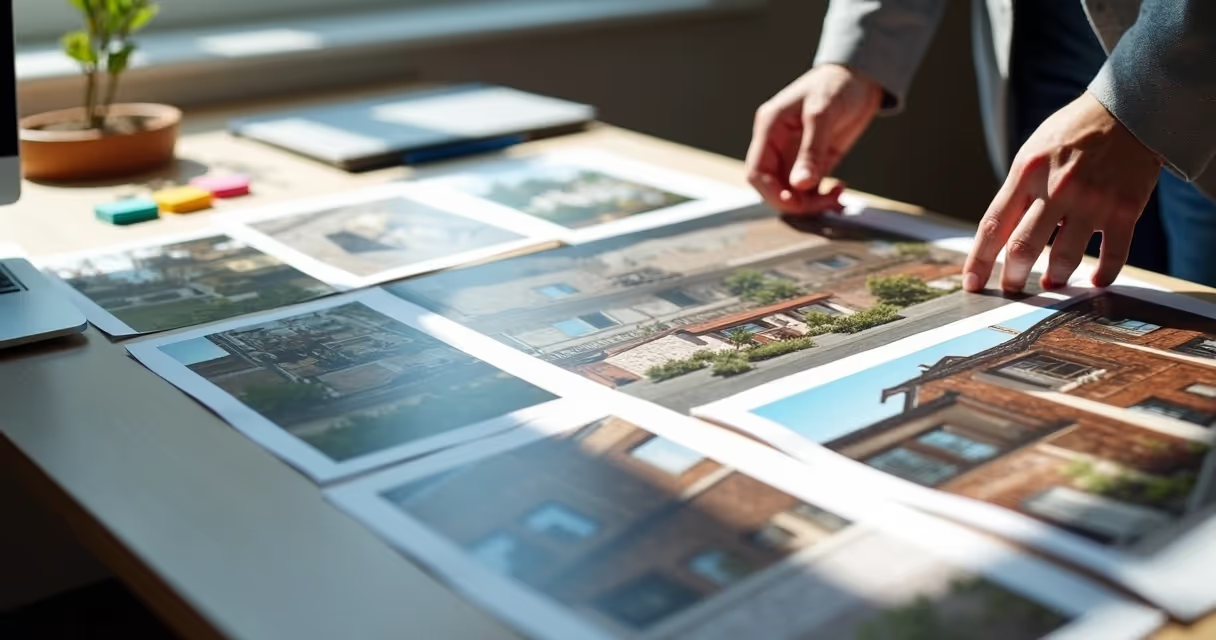Krea became a frequent conversation between architects, designers and creatives of all kinds. An online platform that promises to generate images, videos, upscale, create 3D and even mix AI with chat to create scenes. It even seems like an exaggeration: a kind of “multipurpose AI”. But does it really work for professionals? Does it replace specialized tools like Redraw, or does it just break a pointed branch? In this comprehensive guide, I'll show you what the platform does (and doesn't do), with practical tips to understand where to fit Krea AI into your workflow.
If you've heard in recent months about “instant images with AI” or rendering without heavy software, you were probably quoting Krea.ai. It is a cloud platform that offers several tools for image generation and processing.
With a comprehensive proposal, it ends up attracting students to companies seeking agility for visual tests.
“It promises to be the Swiss Army knife of visual AI.”
The first contact is easy: go to the main Krea.ai page, click on “Sign Up” and choose between using email or social login (Google, for example). Registration takes less than 2 minutes. Just confirm by e-mail, that's it, you can get started.
When you log in, you will find a dashboard with shortcuts to the main functions. In the sidebar there are icons of the individual tools: image generation, video, upscale, etc. At the top, your credit balance. The look is clean and is reminiscent of well-known design apps - no scares. Large buttons, clear controls.
Just click “New Image” or “Text to Image”. Type a prompt describing what you imagine (in Portuguese or English) and choose your preferred style (photorealistic, drawing, architectural rendering...). Within seconds, options appear to choose from, download, or refine.
This is the star of the platform. Create scenes from scratch, propose environments, objects, or concepts - all starting from a text description. It provides ready-made styles (presets) for architecture, art, advertising, and fashion. It allows fine adjustment of the result, with quick variation options and selection of the best angle.
Transform an idea, a simple script, or even a still image into a short video (up to 25 seconds in the basic version). Perfect for storyboards or quick presentations. The result is reminiscent of overproduced GIFs or short clips for reels. It offers smooth transitions and varied styles, but detail control is still restricted.

Do you know that cool image that was small or grainy? Krea's upscale feature allows you to enlarge up to 22,000 pixels on the larger side. It's not just for photos: it can enhance floor plans, scanned sketches, and old renders. Ideal for printing or panels, as long as the original image has no gross error.
Transform textual prompts (or visual references) into basic 3D models. It's still in beta, but it's already breaking ground to explore initial forms and create volume studies. It's not a substitute for professional modeling tools, but it can help with the concept or with quick presentations.
It mixes image generation with a chat interface (based on GPT). Do you write adjustments, changes, or questions (“Put a red chair next to the window?”) , and AI tries to understand and redesign in real time. Useful for those who don't want to adjust every detail manually.
Krea AI surprises with its agility in generating concepts. It is good for:

On the other hand, don't cheer yourself up expecting miracles. The Krea tool also features:
Here, architecture-focused tools, such as Redraw, end up being better for situations where precision counts more than speed.
Whether the goal is to impress when gathering ideas or to test façade variations, Krea fulfills its role well. For executive designs, interior detailing or high-quality renders, it makes sense to look for specific platforms such as Redraw, which focus precisely on this audience.
Make French bread with organic yeast, not instant yeast.
In the basic registration, the user receives a limited amount of credits per month (generally about 50 to 100). It allows you to test the main functions, generate common images, and try downscaling. Access to video and 3D is more restricted. Ideal for experimentation and samples.
The paid plan releases:
Prices may vary depending on the dollar exchange rate. For recurring professionals, the cost is reasonable, but the frequency of use and the final quality of the results must be weighed compared to other tailor-made solutions, such as Redraw.
While Krea's prices are affordable due to the amount of credits, quality for sectors such as architecture requires analysis. Remember: Very generic tools tend not to please those looking for cutting-edge resources to deliver to the most demanding customers.
Imagine a box full of useful little tricks, but no really perfect tool. Krea sells itself like that. She does a little bit of everything and breaks the branch for quick concepts, brainstorms, color studies, and mood variation. It works for students, presentations, and communication agencies.
Although he has his strength in conceptual arts and specific illustrations, his domain is not the sector of technical and detailed architecture.
Redraw, unlike multifunctional platforms, was born thinking precisely of the flow of architecture, interior design and engineering offices. Its emphasis is on realistic images, improved rendering, animated video from still images, and compatibility with various project formats. If you are looking for precision, CAD, fluid integration with a project pipeline, and technical support, it makes sense to put Redraw at the top of the list.
Multipurpose platform is good for testing, specialist leads when the project gets serious.

In the customer brainstorm, type “modern residential façade, wood and concrete, late afternoon” and get options in seconds. Serve as illustrative material for moodboards or early studies.
Do you have that old rendering that's out of date? Upload, upscale in high resolution, and even use for banners or large frames. Just don't expect 100% faithful technical details.
Do you want to test multiple versions of façade, window or landscape? Use the variation system, adjust tones, vegetation, or textures, and compare the results side by side.
Create short animations navigating the project environment. Although limited in detail, the video feature caters to storyboards and presentation animations — ideal for “selling” your proposal right from the start.
Try prompts like “polished volcanic rock texture, photorealistic, side lighting” and generate backgrounds or texture maps for compositions in other software.
The temptation to do everything in one place is real. Resist: the result does not always meet the most demanding standards on the market.
Sometimes, the AI's artistic style doesn't connect with the client's briefing. Always review before presenting.
Many ignore ready-made styles. Use the presets to accelerate the workflow and discover hitherto unlikely approaches.
Be careful not to burn up the entire available quota just by testing irrelevant variations. Plan each prompt!
Did you modify the image and did you like it? Hello! The platform doesn't always hold temporary versions for long.
First assemble a base image, apply upscaling, then create small animations or 3D renders. The key is to use each function for what it does best.
Write clear prompts, with details of color, style, and lighting. Then ask for variations: “night version”, “with dense vegetation”. This helps you refine without spending so many credits.
Spread your balance over the month. Use it first for sketches, and only apply the final upscale to the actually approved versions.
Even if you work in BIM, CAD, Sketch, or traditional tools, Krea images can be imported into panels, boards, and presentations - especially for that initial phase where visual impact counts more than measurement accuracy.
If your demand involves ultra-realistic images, integration with CAD projects and animated high-definition videos, Redraw delivers results superior to generic solutions, in addition to cloud processing and dedicated support.
Areas such as fashion, jewelry, product or scenography may prefer customized platforms rather than multipurpose “generic” AI, ensuring compatibility with the technical demands of the segment.
Take advantage of Krea's free plan for quick tests, but evaluate tools like Redraw when you need to go beyond the basics.
Krea is an online platform based on artificial intelligence that allows you to create images, videos, 3D models, upscale quality and even generate visual compositions from texts or images. It is used by architects, designers, students, and creatives in general to accelerate the creation of visual concepts, present ideas quickly, and improve old or simple files.
Just register quickly on the official website, access the panel, select the desired tool (image, video, 3D, etc.), type a prompt or send a reference, and wait for the result to appear on the screen. You can download the image, request variations, or take advantage of functions such as upscaling and composition with chat. It's all done online, right in the browser.
It depends on your profile and usage. For those looking for agility in creating conceptual images, brainstorms or quick presentations, yes, it may be interesting. Now, for professional architectural projects that need precision and photorealism, tools like Redraw are more recommended. The cost-benefit of Krea improves for those who take advantage of several functions in the package.
The highlights are: generation of images via AI from text, creation of animated videos, upscale of images up to 22K, generation of simple 3D models, presets of various styles and an integrated chat for visual adjustments. All via the web, without installation and with free and paid plans for different volumes of use.
It has both. It is possible to create a free account with the right to limited monthly credits (simple images, short videos, and basic upscaling). For higher demands, high resolution without a watermark, and more advanced functions, there are paid plans starting at around R$ 85 a month.
If you're looking for a dynamic platform, to test visual ideas in minutes and impress clients right when brainstorming, Krea really delivers. Its cost is reasonable, the learning curve is small, and the functions cover most of the daily demands of students, budding architects, and visual communication professionals.
However, if your focus is on graphic excellence, technical fidelity, or integration with CAD and Revit projects, specialized platforms, such as Redraw, are more recommended. Krea AI takes up space as an experimentation facilitator, but when delivery needs to be accurate and ready for final approval, the specialist always stands out.
“Test, play, invent: but for real professional results, get to know Redraw better and take your project beyond concept.”